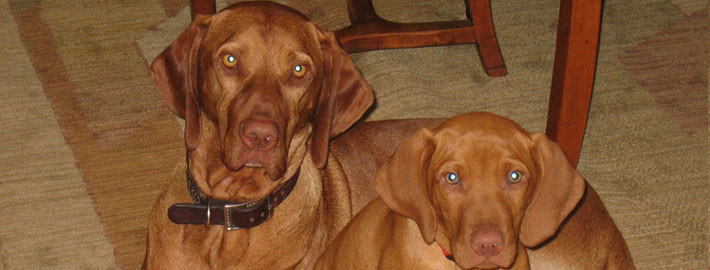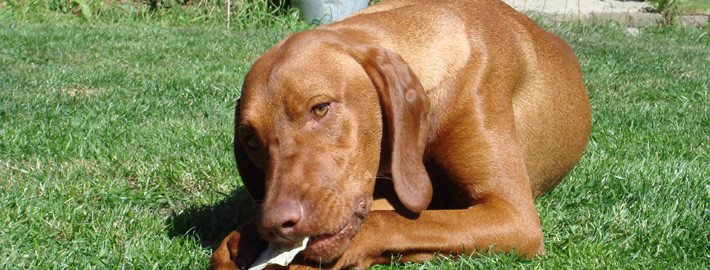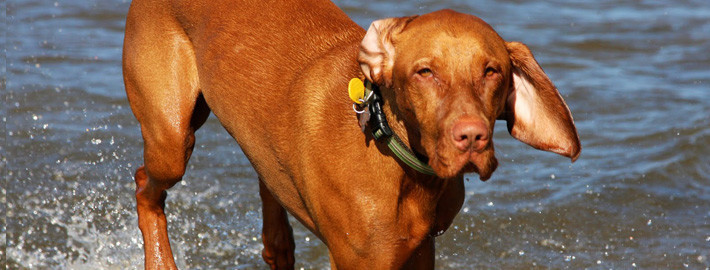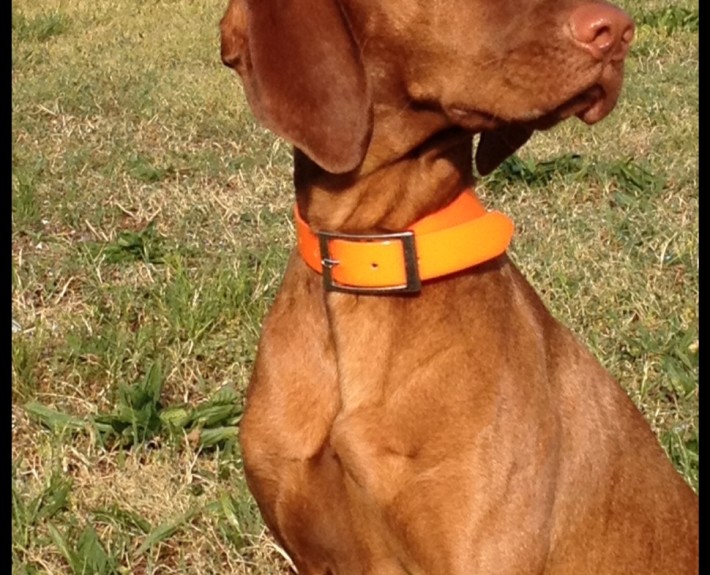What makes the Vizsla Unique?
Vizslas are playful and affectionate dogs that do well as members of active families. They are also a fairly trainable breed.
Breed Groups
Page Contents
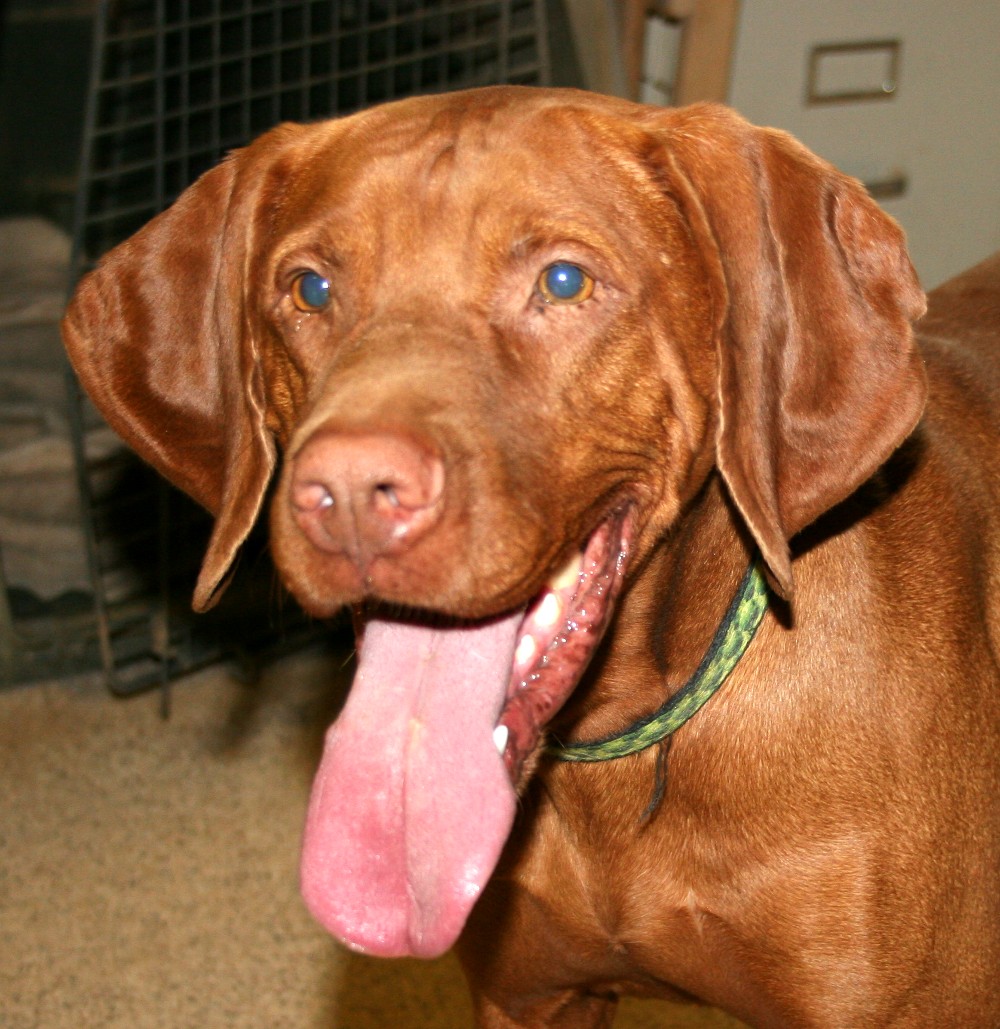
Is the Vizsla Right For You?
They are wonderful companions for active outdoor enthusiasts. Although some will bark at strangers, these dogs are typically very friendly. Vizslas are also devoted family members and enthusiastically attach themselves to their people. Many even prefer to sleep with their owners. While their love of family is an endearing characteristic, it also means that these dogs will need to live indoors in spite of their size to prevent separation anxiety from occurring.
In 5 Words
- Gentle
- Energetic
- Loyal
- Quite
- Affectionate
Characteristics
Learn About the Vizsla
Description
General Description
These hunting dogs are of medium stature. They are somewhat longer than they are tall. Vizslas have athletic bodies with lithe frames that allow them to be very effect in the field. These dogs also possess domed skulls, tapered muzzles, and strong necks. Their teeth should meet in a scissors bite and their eyes should be a different color than their coats. Flesh colored noses are another breed feature. These dogs also have thin ears with rounded ends that hang close to their cheeks. Thick tails are also found on members of this breed. In places where docking is not illegal, this appendage is reduced by 1/3 of its length. Their dewclaws are typically removed. Vizslas also have straight front legs and cat-like feet which enable them to run in a graceful, trotting fashion rather like horses do.
Size
Males of this breed stand between 22 and 26 inches (56 and 66 centimeters) tall. They generally weigh about 45 to 60 pounds (20 to 27 kilograms). Female dogs stand between 20 and 24 inches (51 to 61 centimeters) in height and weigh between 45 and 55 pounds (18 and 25 kilograms) on average.
Coat
Vizslas have dense, close-fitting coats that help protect them from inclement weather conditions. They are usually golden rust in color. According to the American Kennel Club, acceptable variations include golden, rust, red, sandy golden, red golden, and rust golden. Some dogs may also have white markings. The Fédération Cynologique Internationale breed standards state that russet gold and sandy gold coats are acceptable as are the white markings, but “red, brownish, or lightened color is undesirable”.
Short History of the Vizsla
Native to Austria and Hungary, Vizslas descended from the hunting dogs that the Magyars people brought with them when they settled the region. Members of this breed were experts at detecting game and flushing it out of thick underbrush. There is evidence that the breed was definitely in existence by the Middle Ages. During that period, they served as both companions and hunting dogs to members of the aristocracy.
Despite the fact that there have been numerous wars and conflicts in the region, these dogs persevered for the hundreds of years that followed. While the breed was somewhat reduced in numbers during the 19th century, they have since come back from this decline to be more popular than ever before. The dogs made their way to the United States during the 1950s. Vizslas were accepted to the Fédération Cynologique Internationale in 1954 and they were officially recognized by the American Kennel Club six years later.
Temperament
It goes without saying that Vizslas are quite energetic and require plenty of daily exercise. They are wonderful companions for active outdoor enthusiasts. Although some will bark at strangers, these dogs are typically very friendly. Vizslas are also devoted family members and enthusiastically attach themselves to their people. Many even prefer to sleep with their owners. While their love of family is an endearing characteristic, it also means that these dogs will need to live indoors in spite of their size to prevent separation anxiety from occurring. Vizslas that are unhappy may also cry or whine. Members of this breed usually respond well to instruction but some can be stubborn. Properly trained dogs are great with children. Those that have not been trained still get along well with youngsters but may mouth them as they would other puppies and playtime should therefore be supervised.
Caring for Your Vizsla
General Health
Born in litters averaging about 7 puppies, these dogs typically live between 9 and 15 years. The earlier population decline caused some inbreeding to revive the breed, which in turn lead to the prevalence of some health problems that now exist in Vizslas. Progressive retinal atrophy, entropion, ectropion, dysphagia-megaesophagus, corneal dystrophy, and muscle atrophy are serious ailments that can all arise from time to time. Excessive drooling, allergies, and inflamed skin may also be problematic in some dogs.
Care
Daily
Vizslas need at least 30 minutes of exercise per day, but that is only a rough estimate and some dogs may require longer play times. Owners may prefer to break the recommended block of exercise time into two shorter segments rather than getting it all done in one trip. Vizslas enjoy jogging, hiking, and accompanying bicyclists on their daily excursions. Games of fetch are another favorite pastime for members of this breed
Weekly
Regular brushing of a dog’s teeth will prevent health problems and will also help eliminate foul breath.
Monthly
Parasite prevention medication is a must for all dogs and these products are typically administered on a monthly basis.
Grooming & Bathing
These dogs shed an average amount of fur and should be brushed every so often to remove loose hair. They will only need to be bathed when they get dirty. It is also a good idea to keep their nails trimmed to prevent injuries from occurring.
Exercise & Training
As Vizslas were originally bred to be hunting dogs, it is no wonder that they serve this purpose so excellently. They can point out prey and also retrieve game that has been downed in either the water or on land. Members of this breed are also great swimmers, but some may initially need an incentive to get in the water.
Vizslas are intelligent and eager to please. These characteristic make them relatively easy to train as long as their owner maintains consistent rules and puts forth a steady effort in teaching them. These dogs have a particularly sensitive disposition and, as a result, they should not be exposed to harsh training methods. However, owners that do not display appropriate amounts of authority during the dog’s lessons are likely to be ignored. Vizslas also benefit greatly from early socialization with both humans and other animals.
Members of this breed will need to get plenty of exercise. Otherwise, they are prone to racing about the house and destroying things due to boredom. Owner should additionally keep in mind that these dogs have a high prey drive. Therefore, Vizslas should not be allowed off their leash in town unless they are hanging out in a place where their habit of chasing smaller animals will not cause problems.

